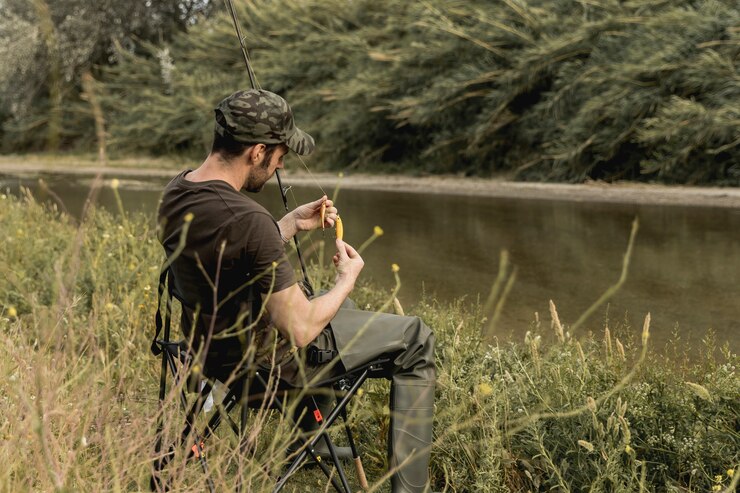The Striped Bass, commonly known as Striper, is a revered game fish among anglers. Its strength, speed, and the thrill of catching one make it a favorite target for both amateur and professional fishermen. In this comprehensive guide, we’ll delve into everything about the Striper fish, from its habits to tips for successful fishing.
What is a Striper?
The Striper (Morone saxatilis) is a species of temperate bass native to the Atlantic coast of North America. While typically found in saltwater, Stripers are anadromous, meaning they migrate between saltwater and freshwater. This migration allows them to breed and find food efficiently.
They are easily recognizable by the seven or eight dark horizontal stripes running down their silvery-white sides, giving them their name. With a torpedo-shaped body, large mouth, and powerful tail, Stripers are well-suited for speed and strength, making them exciting to catch.
Where Can You Find Striper?
Stripers are most commonly found in the Atlantic Ocean, stretching from Nova Scotia down to Florida. They inhabit bays, estuaries, and coastal areas and often swim upriver to spawn in freshwater. Stripers are also popular in the Pacific, where they were introduced in the late 1800s in California. These fish thrive in a variety of habitats, including rivers, lakes, and reservoirs.
While the Striper’s natural range lies along the East Coast of the United States, their adaptability to freshwater environments has led to the creation of many landlocked populations in inland lakes across the country.
Striper Habits and Behavior
Stripers are predatory fish, feeding primarily on smaller fish like herring, shad, and menhaden. They are known to be aggressive feeders, especially during dawn and dusk, when they are most active. Their diet also includes crustaceans and invertebrates.
During spawning season, which typically takes place in the spring, Stripers migrate upstream to freshwater rivers and tributaries. Water temperature plays a crucial role in the spawning process, with optimal conditions being between 60 to 68°F (15.5 to 20°C). Striper populations in different regions may spawn at slightly different times, depending on the local climate and water conditions.
After spawning, the adult Stripers return to the ocean or their lake habitat, while the juveniles spend their early years in freshwater before joining the adults in saltwater.
Why Are Stripers Popular Among Anglers?
Striped Bass are prized among sport fishers for several reasons:
- Size and Power: Stripers are large, powerful fish that put up a great fight when hooked. Some Stripers can grow to be over 50 pounds (22.6 kg), making them a rewarding catch.
- Challenge: Their strength, speed, and unpredictable behavior make them a challenge even for experienced anglers. Whether in saltwater or freshwater, catching a Striper can be a thrilling experience.
- Taste: Striper meat is highly sought after for its mild, sweet flavor. Whether grilled, baked, or fried, Stripers are considered a delicacy.
Types of Striper Fishing
There are various techniques for catching Striper fish, each depending on the location, water conditions, and personal preference. Below are some of the most popular methods:
1. Surf Fishing for Stripers
Surf fishing involves standing on the shore and casting bait or lures into the surf where Stripers are feeding. This method is particularly popular along the East Coast, where anglers cast from beaches, piers, or jetties. The key to success in surf fishing is to match your bait to what the Stripers are feeding on in that area, whether it’s sand eels, clams, or crabs.
Tip: Use a long surf rod (10-12 feet) to cast far enough into the surf. Popular bait options include live eels, bunker, or cut bait.
2. Boat Fishing for Stripers
Fishing for Stripers from a boat allows anglers to cover more water and reach deeper areas where Stripers may be hiding. Trolling is one of the most effective techniques used from boats, where anglers drag bait or lures behind the boat at varying depths. This method helps locate schools of Stripers and keeps the bait moving, attracting the fish’s attention.
Tip: Use electronics like fish finders to locate schools of baitfish, which often means Stripers are nearby.
3. Fly Fishing for Stripers
Fly fishing for Stripers has gained popularity in recent years, offering a unique challenge for those who enjoy finesse and technique. Stripers can be caught on the fly in both freshwater and saltwater, especially when they are actively feeding on baitfish near the surface. Large streamers or imitation baitfish patterns are commonly used to entice strikes.
Tip: Focus on areas with strong currents or rips, where baitfish are likely to be swept through, drawing in hungry Stripers.
4. Ice Fishing for Stripers
In certain areas with landlocked populations, Stripers can be caught even during the winter months when lakes freeze over. Ice fishing for Stripers is typically done in large reservoirs or lakes, where anglers drill holes in the ice and drop bait or jigs down to where the fish are holding. Electronics such as fish finders are invaluable in locating Stripers under the ice.
Tip: Look for areas where the lake bottom drops off into deeper water, as Stripers tend to hold near these ledges during the winter.
Essential Gear for Striper Fishing
Fishing for Stripers requires specific equipment depending on the method you choose. Here’s a rundown of essential gear for targeting these powerful fish:
- Rod and Reel: The right rod and reel will depend on the type of fishing you’re doing. Surf fishing requires longer rods (10-12 feet), while boat fishing may call for shorter, sturdier rods. A medium to heavy-action rod is best for handling the size and power of Stripers.
- Line: Braided line is a popular choice for Striper fishing due to its strength and sensitivity. A 30-50 lb test line is typically used, though this may vary depending on the size of the fish you’re targeting and the water conditions.
- Lures and Bait: Live bait such as eels, bunker, and herring are all excellent choices for Striper fishing. In addition to live bait, artificial lures like swimbaits, topwater plugs, and soft plastics can be effective in attracting Stripers. Match your lure to the size of the baitfish in the area for the best results.
- Hooks and Weights: Circle hooks are often used for live bait fishing, as they help ensure the fish is hooked securely without causing unnecessary harm. Weights are essential for keeping your bait at the right depth, particularly when surf or deep-water fishing.
Best Times to Fish for Striper
Timing is key to successful Striper fishing, as these fish are more active during certain times of the day and year. Here are a few factors to consider:
- Season: Spring and fall are prime times for Striper fishing. During the spring, Stripers migrate to freshwater rivers to spawn, making them more accessible. In the fall, they return to coastal waters and feed heavily in preparation for winter.
- Tides: Stripers are heavily influenced by tidal movements, and fishing during changing tides often yields the best results. High tide, especially around dawn and dusk, is a prime time to target Stripers.
- Time of Day: Early morning and late evening are when Stripers are most active, as they tend to feed more during low-light conditions. However, fishing at night can also be highly productive, especially in areas with strong tidal currents.
Conservation and Regulations for Striper Fishing
Due to their popularity, Striper populations have faced pressures from overfishing and habitat degradation. Many states have implemented regulations to protect these fish and ensure sustainable populations for future generations.
Catch Limits: Most states have strict catch limits and size restrictions for Stripers. It’s important to know the regulations in your area before fishing. Many places require Stripers to be a certain size before they can be legally kept, and there are often limits on how many fish an angler can take in a single day.
Conservation Efforts: In some areas, catch-and-release fishing is encouraged to protect Striper populations, particularly during spawning seasons. Using barbless hooks and practicing proper catch-and-release techniques can help ensure that these fish survive after being released.
Conclusion
Striped Bass, or Stripers, are not only a thrilling catch but also an important species in both saltwater and freshwater ecosystems. Whether you’re a seasoned angler or just starting, Striper fishing offers endless excitement and challenges. With their large size, fighting ability, and the variety of fishing techniques available, Stripers are a rewarding target for any fisherman.
Make sure to equip yourself with the right gear, familiarize yourself with local regulations, and use the tips provided to improve your chances of landing one of these remarkable fish.
FAQs
What is the best bait for Striper fishing?
The best bait for Striper fishing depends on the location and season. Live bait such as eels, bunker, and herring are commonly used, while artificial lures like swimbaits and topwater plugs can also be effective.
What is the best time of year to fish for Striper?
Spring and fall are the best times for Striper fishing, as these are the periods when Stripers are most active and accessible. During the spring, they migrate to freshwater to spawn, while in the fall, they feed heavily in preparation for winter.
How big do Striper fish get?
Stripers can grow to be over 50 pounds (22.6 kg), though the average size caught by most anglers is between 10-20 pounds (4.5-9 kg).
Are Striper fish good to eat?
Yes, Striper fish are highly regarded for their mild, sweet flavor. They can be prepared in various ways, including grilling, baking, and frying.
Is Striper fishing regulated?
Yes, most states have regulations regarding Striper fishing, including catch limits, size restrictions, and seasons. It’s important to check local regulations before fishing for Stripers.







